Fully Biodegradable Composites: Thermal, Flammability, Moisture Absorption and Mechanical Properties of Natural Fibre-Reinforced Composites with Nano-Hydroxyapatite
Abstract
1. Introduction
2. Materials and Methods
2.1. Materials
2.2. Processing
2.3. Flammability Test
2.4. Thermogravimetric Analysis (TGA)
2.5. Differential Scanning Calorimeter (DSC) Test
2.6. Scanning Electron Microscopy (SEM)
2.7. Tensile Test
2.8. Flexural Test
2.9. Water Absorption Test
3. Results
3.1. Flammability of Poly(lactic Acid) (PLA), Control and Nano-Hydroxyapatite (nHA)-Filled Composites
3.2. Thermal Studies
3.3. Crystallization and Melting Properties
3.4. Morphological Properties
3.5. Tensile Properties
3.6. Flexural Properties
3.7. Water Absorption Behaviors
4. Conclusions
Author Contributions
Funding
Conflicts of Interest
References
- Hapuarachchi, T.D.; Peijs, T. Multiwalled carbon nanotubes and sepiolite nanoclays as flame retardants for polylactide and its natural fibre reinforced composites. Compos. Part A Appl. Sci. Manuf. 2010, 41, 954–963. [Google Scholar] [CrossRef]
- Plackett, D.; Løgstrup Andersen, T.; Batsberg Pedersen, W.; Nielsen, L. Biodegradable composites based on l-polylactide and jute fibres. Compos. Sci. Technol. 2003, 63, 1287–1296. [Google Scholar] [CrossRef]
- Barkoula, N.M.; Garkhail, S.K.; Peijs, T. Biodegradable composites based on flax/polyhydroxybutyrate and its copolymer with hydroxyvalerate. Ind. Crops A Prod. 2010, 31, 34–42. [Google Scholar] [CrossRef]
- Gurunathan, T.; Mohanty, S.; Nayak, S.K. A review of the recent developments in biocomposites based on natural fibres and their application perspectives. Compos. Part A Appl. Sci. Manuf. 2015, 77, 1–25. [Google Scholar] [CrossRef]
- Väisänen, T.; Das, O.; Tomppo, L. A review on new bio-based constituents for natural fiber-polymer composites. J. Clean. Prod. 2017, 149, 582–596. [Google Scholar] [CrossRef]
- Khalili, P.; Tshai, K.; Hui, D.; Kong, I. Synergistic of ammonium polyphosphate and alumina trihydrate as fire retardants for natural fiber reinforced epoxy composite. Compos. Part B Eng. 2017, 114, 101–110. [Google Scholar] [CrossRef]
- Shen, L.; Patel, M.K. Life Cycle Assessment of Polysaccharide Materials: A Review. J. Polym. Environ. 2008, 16, 154. [Google Scholar] [CrossRef]
- Corbière-Nicollier, T.; Gfeller Laban, B.; Lundquist, L.; Leterrier, Y.; Månson, J.A.E.; Jolliet, O. Life cycle assessment of biofibres replacing glass fibres as reinforcement in plastics. Res. Conserv. Recycl. 2001, 33, 267–287. [Google Scholar] [CrossRef]
- John, M.J.; Thomas, S. Biofibres and biocomposites. Carbohydr. Polym. 2008, 71, 343–364. [Google Scholar] [CrossRef]
- Khalili, P.; Tshai, K.Y.; Kong, I. Natural fibre reinforced expandable graphite filled composites: Evaluation of the flame retardancy, thermal and mechanical performances. Compos. Part A Appl. Sci. Manuf. 2017, 100, 194–205. [Google Scholar] [CrossRef]
- Rodríguez-Robledo, M.C.; González-Lozano, M.A.; Ponce-Peña, P.; Quintana Owen, P.; Aguilar-González, M.A.; Nieto-Castañeda, G.; Bazán-Mora, E.; López-Martínez, R.; Ramírez-Galicia, G.; Poisot, M. Cellulose-Silica Nanocomposites of High Reinforcing Content with Fungi Decay Resistance by One-Pot Synthesis. Materials 2018, 11, 575. [Google Scholar] [CrossRef]
- Biswal, M.; Mohanty, S.; Nayak, S.K. Thermal stability and flammability of banana-fiber-reinforced polypropylene nanocomposites. J. Appl. Polym. Sci. 2012, 125, E432–E443. [Google Scholar] [CrossRef]
- Subasinghe, A.; Das, R.; Bhattacharyya, D. Materials, N. Study of thermal, flammability and mechanical properties of intumescent flame retardant PP/kenaf nanocomposites. Int. J. Smart Nano Mater. 2016, 7, 202–220. [Google Scholar] [CrossRef]
- Hapuarachchi, T.; Ren, G.; Fan, M.; Hogg, P.; Peijs, T. Fire retardancy of natural fibre reinforced sheet moulding compound. Appl. Compos. Mater. 2007, 14, 251–264. [Google Scholar] [CrossRef]
- Akindoyo, J.O.; Beg, M.D.; Ghazali, S.; Heim, H.P.; Feldmann, M. Effects of surface modification on dispersion, mechanical, thermal and dynamic mechanical properties of injection molded PLA-hydroxyapatite composites. Compos. Part A Appl. Sci. Manuf. 2017, 103, 96–105. [Google Scholar] [CrossRef]
- Akindoyo, J.O.; Beg, M.D.; Ghazali, S.; Heim, H.P.; Feldmann, M. Impact modified PLA-hydroxyapatite composites–Thermo-mechanical properties. Compos. Part A Appl. Sci. Manuf. 2018, 107, 326–333. [Google Scholar] [CrossRef]
- ISO. Thermal Properties. In Method 140A: Determination of the Burning Behaviour of Horizontal and Vertical Specimens in Contact with a Small-Flame Ignition Source; International Organization for Standardization: Geneva, Switzerland, 1992; Vol. BS 2782-1: Method 140A: 1992 ISO 1210:1992. [Google Scholar]
- Pilla, S.; Gong, S.; O’Neill, E.; Rowell, R.M.; Krzysik, A.M. Polylactide-pine wood flour composites. Polym. Eng. Sci. 2008, 48, 578–587. [Google Scholar] [CrossRef]
- ISO. Plastics—Determination of Tensile Properties. In Part 4: Test Conditions for Isotropic and Orthotropic Fibre-Reinforced Plastic Composites; International Organization for Standardization: Geneva, Switzerland, 1997; Vol. BS EN ISO BS EN ISO 527-4:1997 BS 2782-3: Method 326F:1997. [Google Scholar]
- Fibre-Reinforced Plastic Composites—Determination of Flexural Properties; International Organization for Standardization: Geneva, Switzerland, 2011; British Standard: 2011; Vol. BS EN ISO 14125:1998 +A1:2011.
- ISO. Plastics—Determination of Water Absorption; International Organization for Standardization: Geneva, Switzerland, 2008; Vol. BS EN ISO 62:2008. [Google Scholar]
- Bourbigot, S.; Fontaine, G. Flame retardancy of polylactide: An overview. Polym. Chem. 2010, 1, 1413–1422. [Google Scholar] [CrossRef]
- Bocz, K.; Szolnoki, B.; Marosi, A.; Tábi, T.; Wladyka-Przybylak, M.; Marosi, G. Flax fibre reinforced PLA/TPS biocomposites flame retarded with multifunctional additive system. Polym. Degrad. Stab. 2014, 106, 63–73. [Google Scholar] [CrossRef]
- Yang, H.; Yan, R.; Chen, H.; Lee, D.H.; Zheng, C. Characteristics of hemicellulose, cellulose and lignin pyrolysis. Fuel 2007, 86, 1781–1788. [Google Scholar] [CrossRef]
- Alvarez, V.; Rodriguez, E.; Vázquez, A. Thermaldegradation and decomposition of jute/vinylester composites. J. Therm. Anal. Calorim. 2006, 85, 383–389. [Google Scholar] [CrossRef]
- Cucuruz, A.T.; Andronescu, E.; Ficai, A.; Ilie, A.; Iordache, F. Synthesis and characterization of new composite materials based on poly(methacrylic acid) and hydroxyapatite with applications in dentistry. Int. J. Pharm. 2016, 510, 516–523. [Google Scholar] [CrossRef]
- Tesoro, G. Textbook of Polymer Science, 3rd ed; Billmeyer, F.W., Jr., Ed.; Wiley-Interscience: New York, NY, USA, 1984; 578p, No price given. [Google Scholar] [CrossRef]
- Liuyun, J.; Chengdong, X.; Lixin, J.; Dongliang, C.; Qing, L. Effect of n-HA content on the isothermal crystallization, morphology and mechanical property of n-HA/PLGA composites. Mater. Res. Bull. 2013, 48, 1233–1238. [Google Scholar] [CrossRef]
- Huda, M.S.; Drzal, L.T.; Mohanty, A.K.; Misra, M. The effect of silane treated- and untreated-talc on the mechanical and physico-mechanical properties of poly(lactic acid)/newspaper fibers/talc hybrid composites. Compos. Part B Eng. 2007, 38, 367–379. [Google Scholar] [CrossRef]
- Aydın, M.; Tozlu, H.; Kemaloglu, S.; Aytac, A.; Ozkoc, G. Effects of Alkali Treatment on the Properties of Short Flax Fiber–Poly(Lactic Acid) Eco-Composites. J. Polym. Environ. 2011, 19, 11–17. [Google Scholar] [CrossRef]
- Wang, X.; Li, Y.; Wei, J.; de Groot, K. Development of biomimetic nano-hydroxyapatite/poly(hexamethylene adipamide) composites. Biomaterials 2002, 23, 4787–4791. [Google Scholar] [CrossRef]
- Baghaei, B.; Skrifvars, M.; Salehi, M.; Bashir, T.; Rissanen, M.; Nousiainen, P. Novel aligned hemp fibre reinforcement for structural biocomposites: Porosity, water absorption, mechanical performances and viscoelastic behaviour. Compos. Part A Appl. Sci. Manuf. 2014, 61, 1–12. [Google Scholar] [CrossRef]
- Mofokeng, J.P.; Luyt, A.S.; Tábi, T.; Kovács, J. Comparison of injection moulded, natural fibre-reinforced composites with PP and PLA as matrices. J. Thermoplast. Compos. Mater. 2011, 25, 927–948. [Google Scholar] [CrossRef]
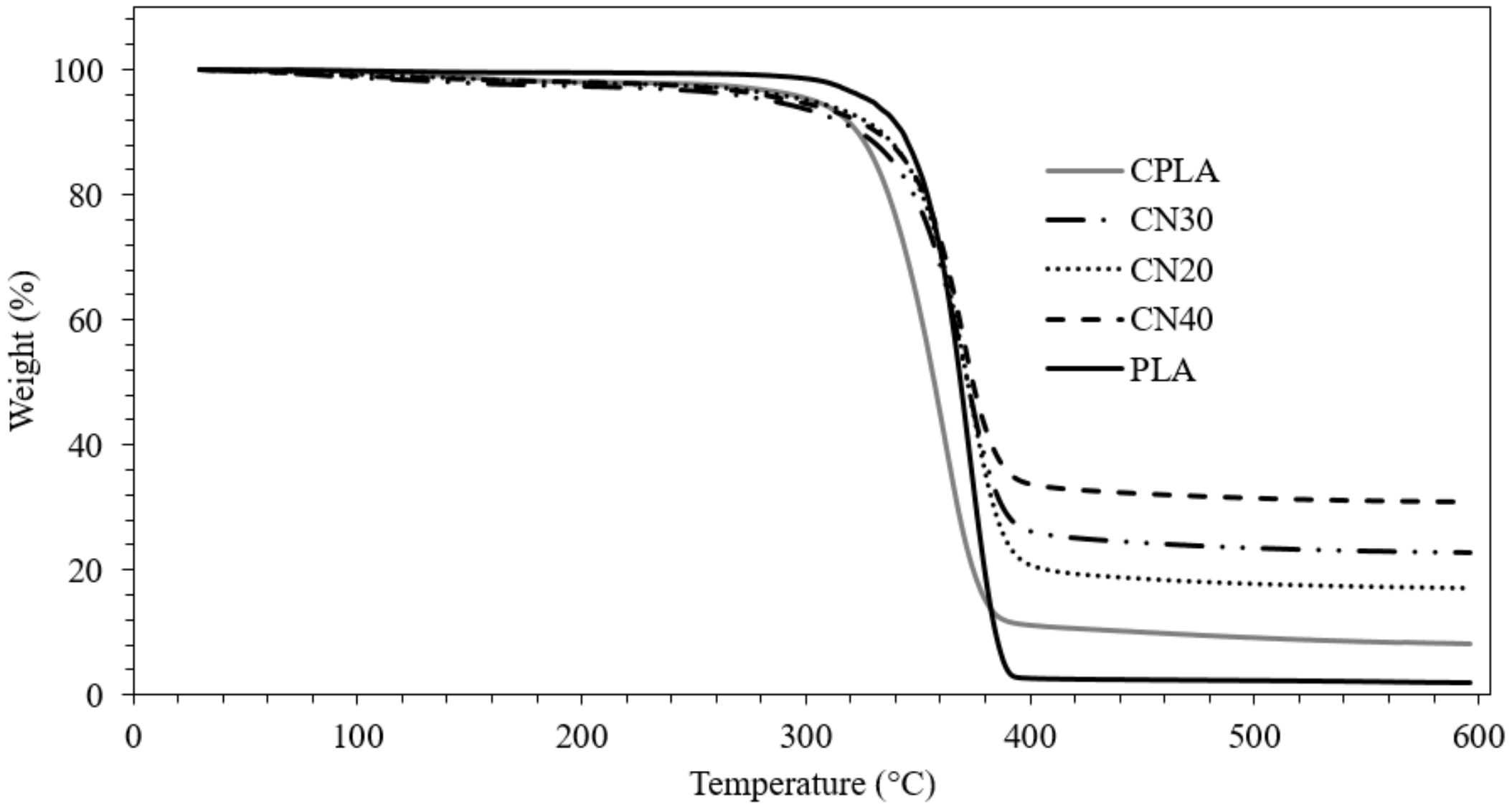
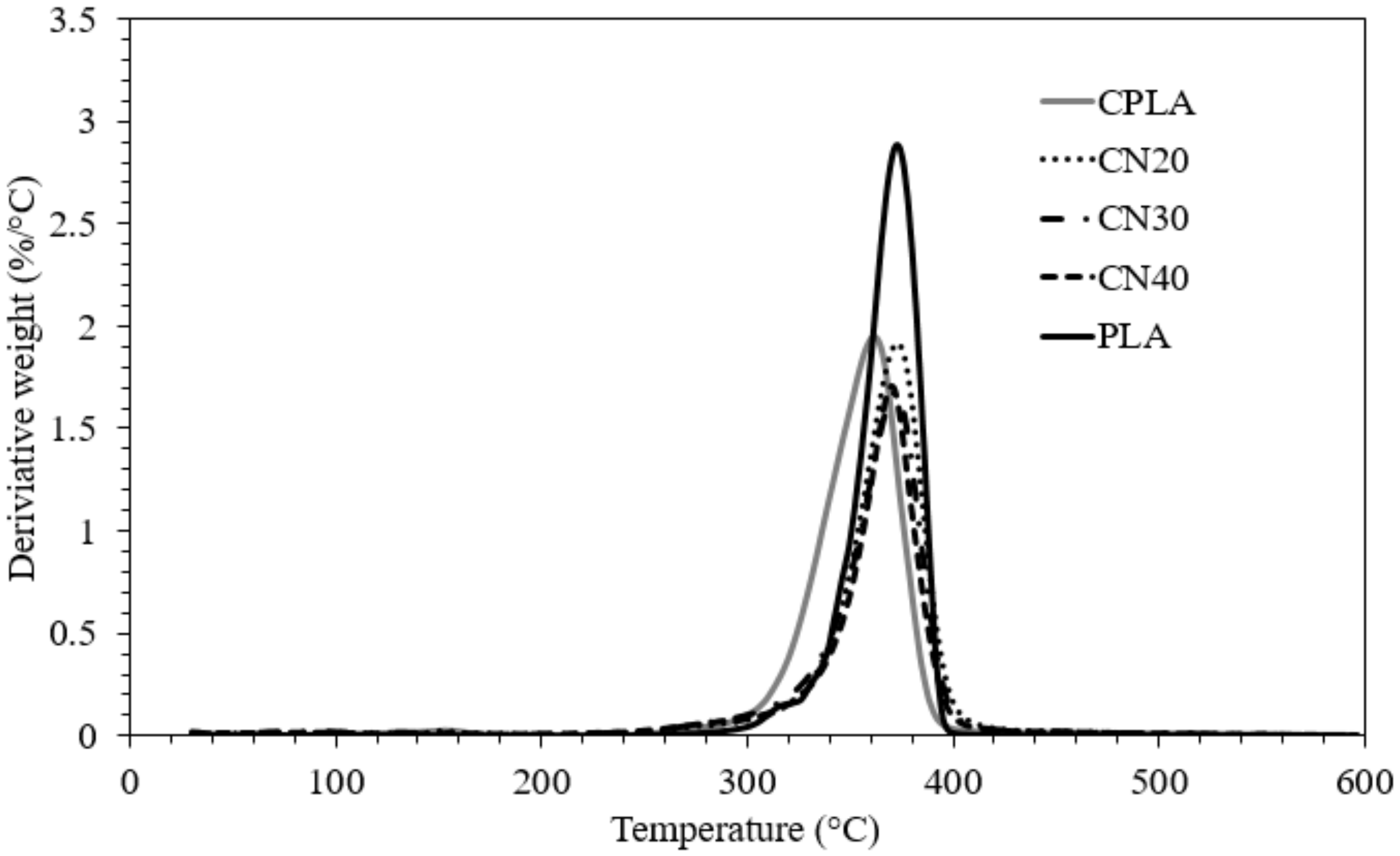
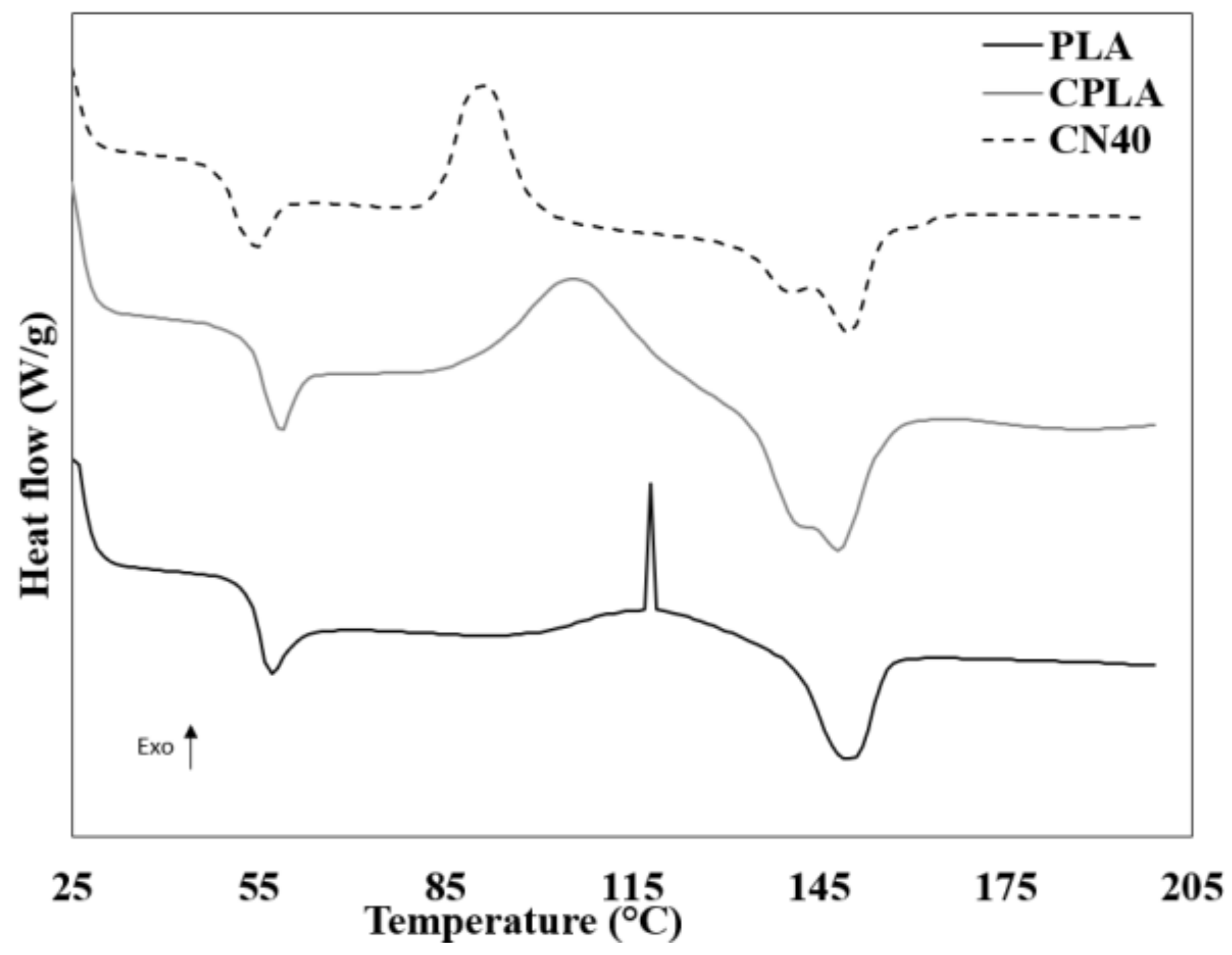
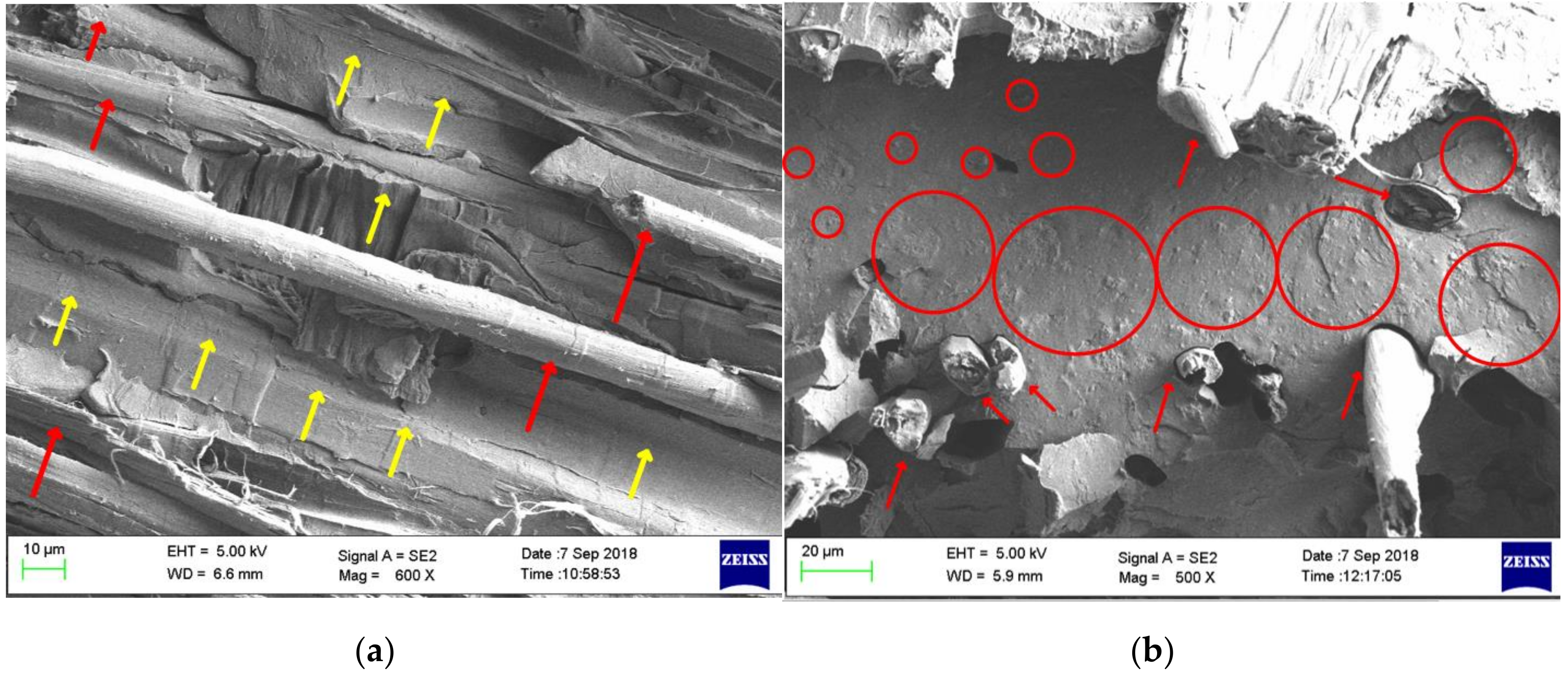
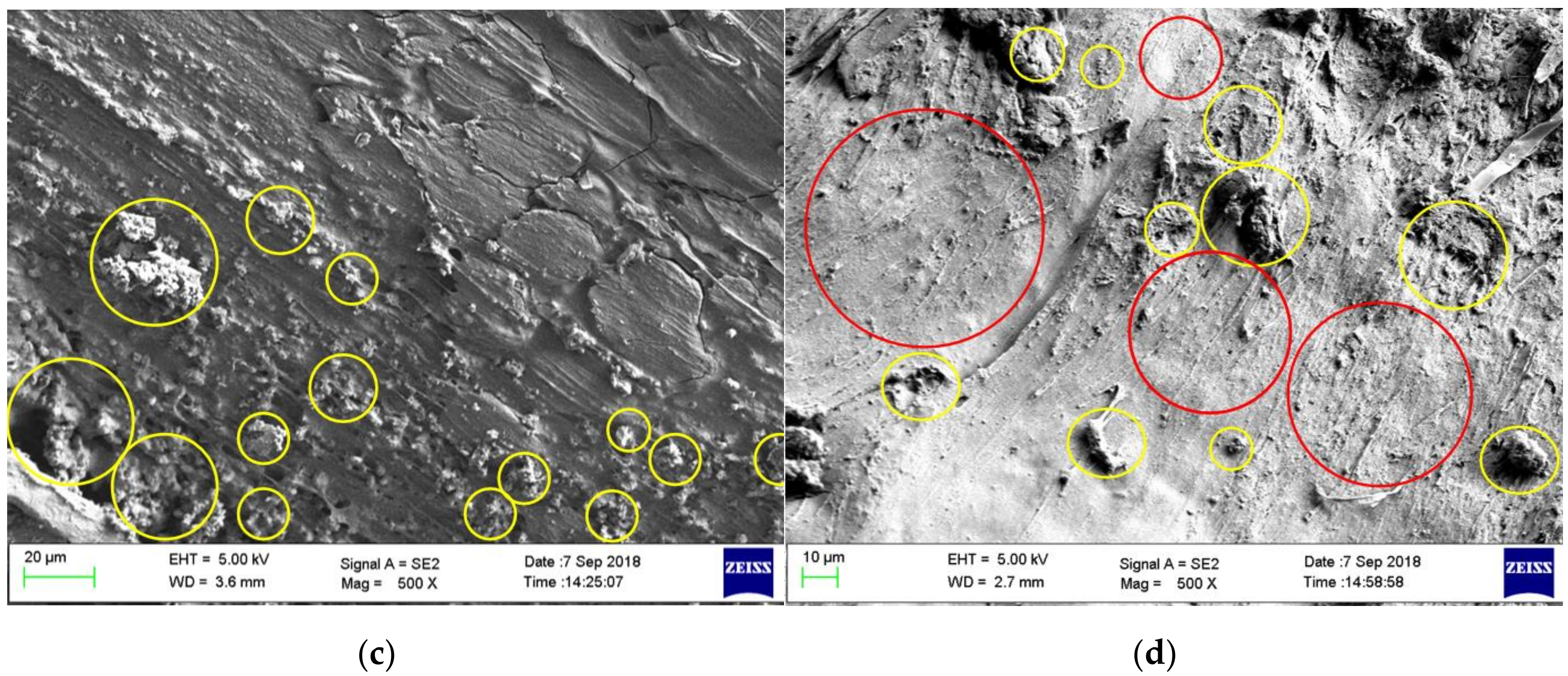
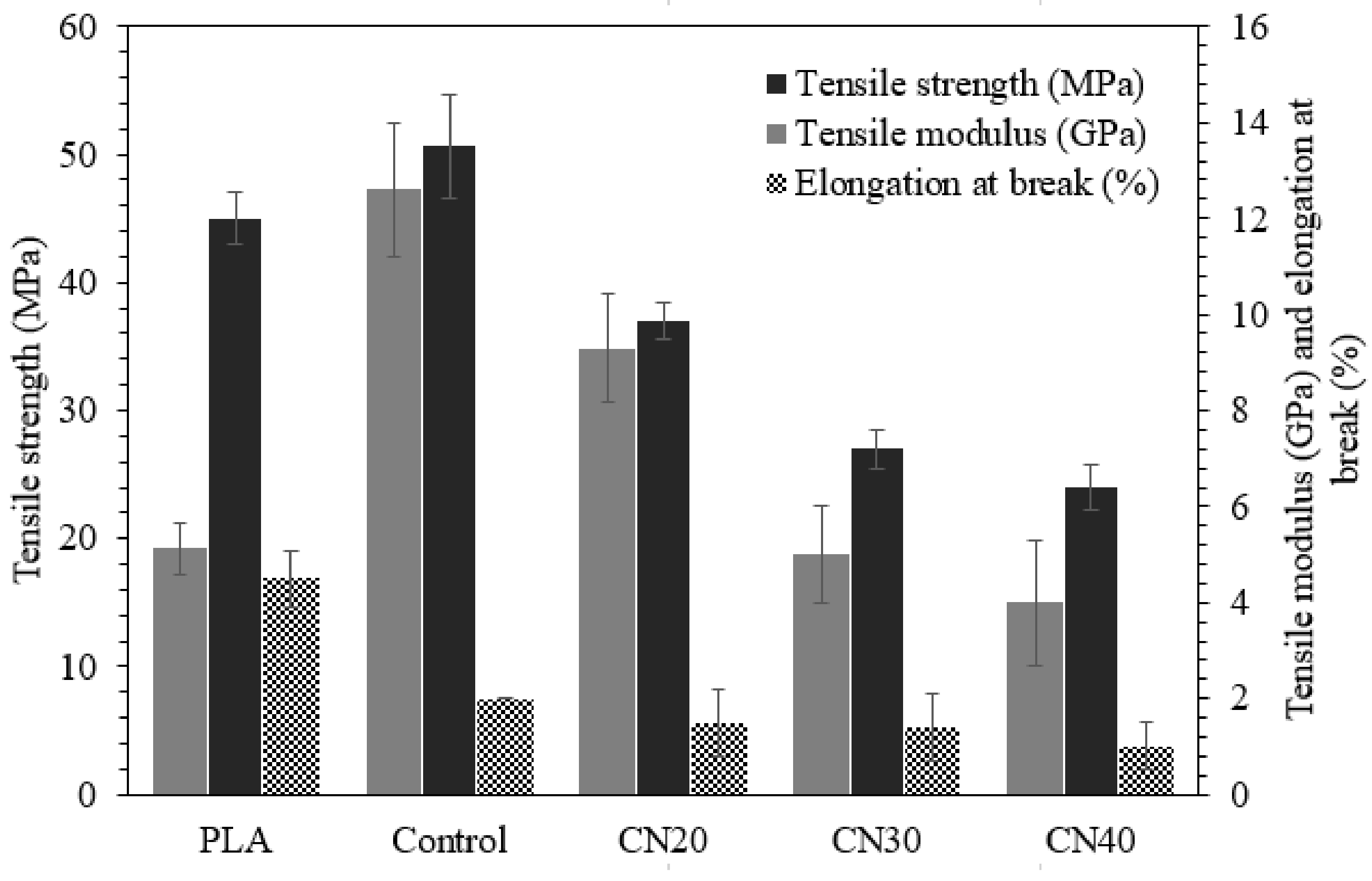
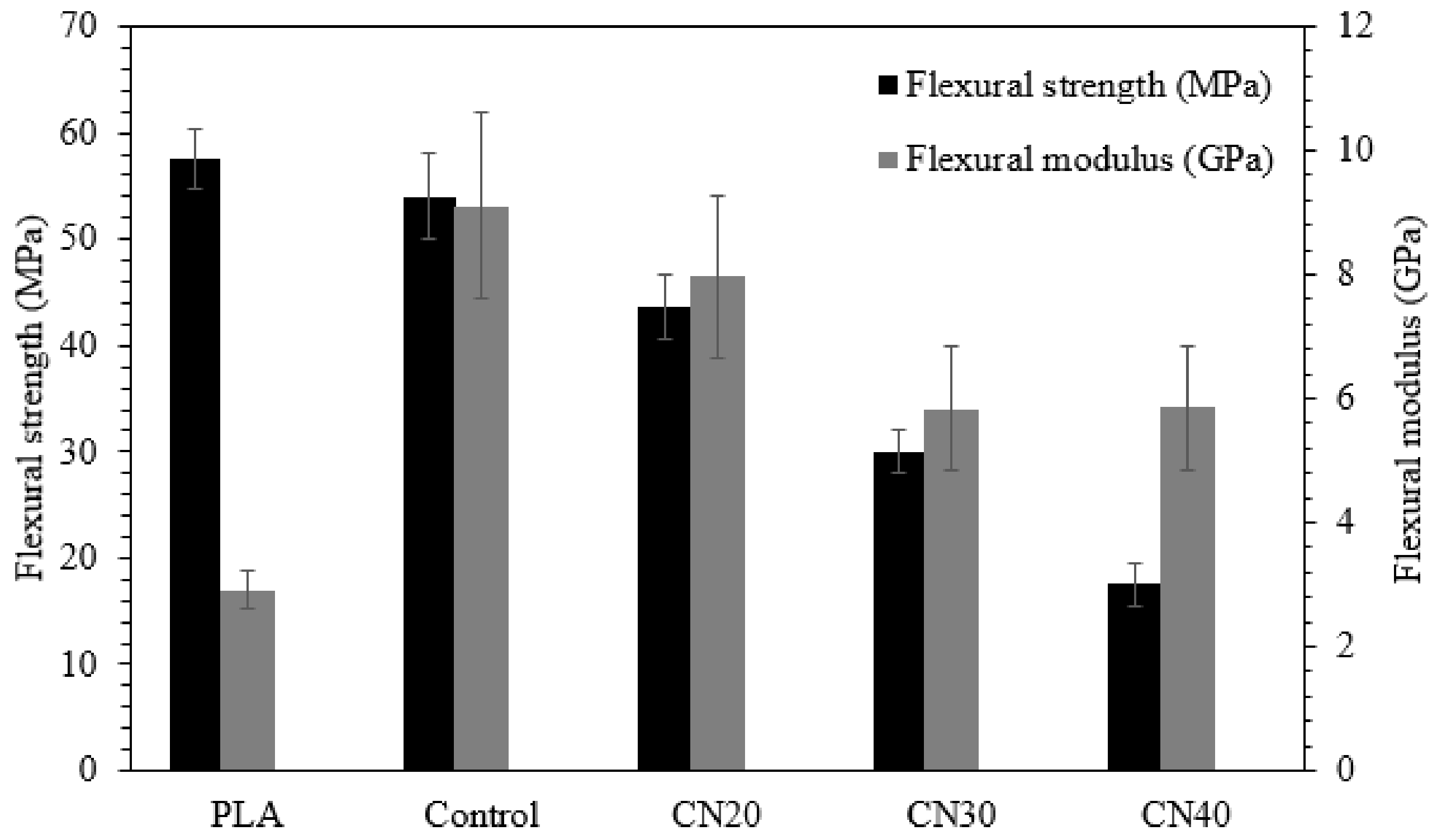

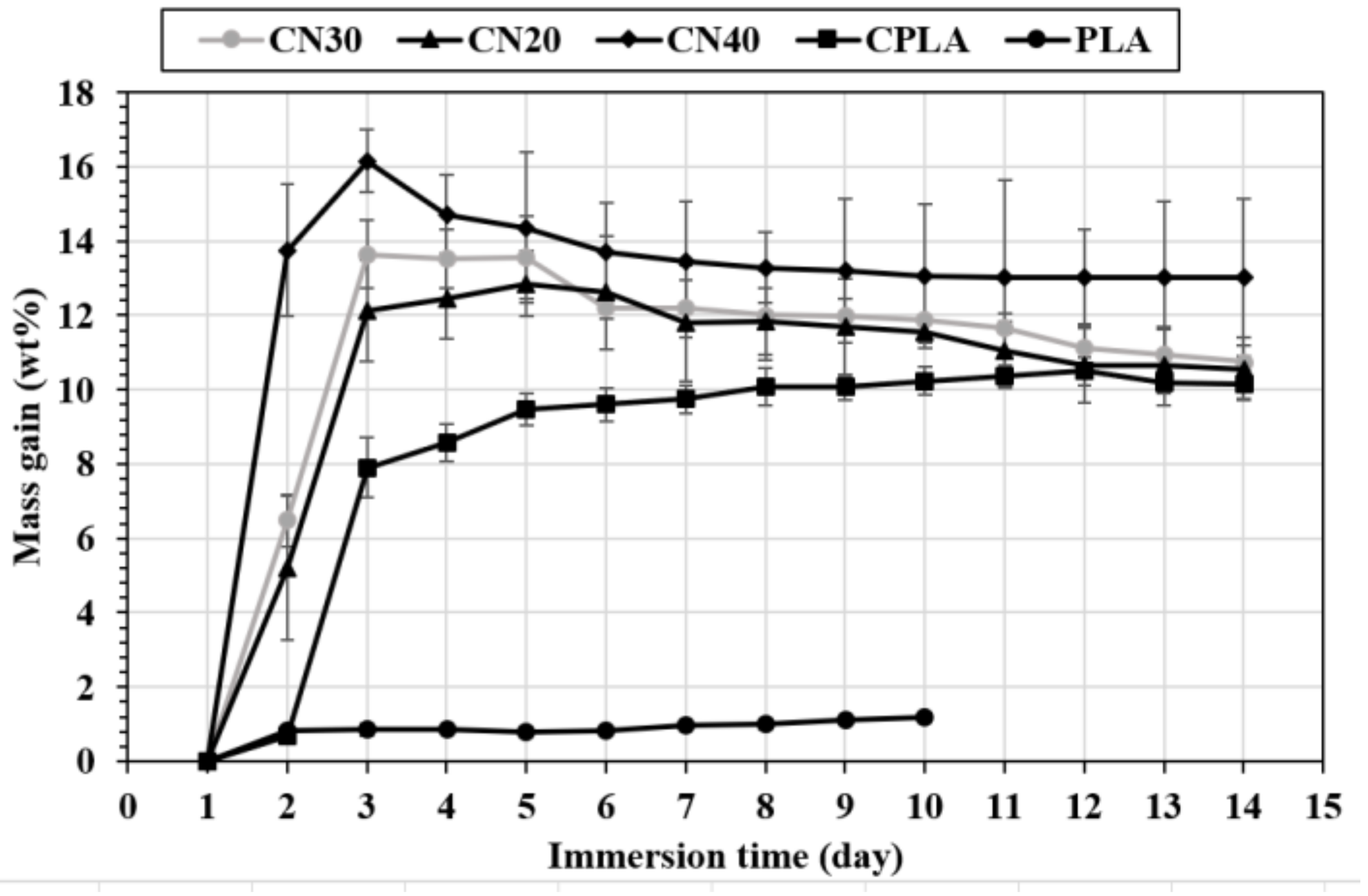
| Sample | Burn Rate (mm/min) | UL 94 Rating |
|---|---|---|
| PLA | NA | FH-2-31 mm |
| CPLA | 20 | FH-3 |
| CN20 | 19.6 | FH-3 |
| CN30 | 17.7 | FH-3 |
| CN40 | NA | FH-1 |
| Samples | Tg (°C) | Tc (°C) | Tm (°C) | ΔHc (J/g) | ΔHm (J/g) | XDSC (%) |
|---|---|---|---|---|---|---|
| PLA | 57 | 118 | 150 | 6.02 | 9.04 | 4.95 |
| CPLA | 59 | 106 | 148 | 17.47 | 18.41 | 1.54 |
| CN40 | 56 | 92 | 151 | 13.83 | 15.04 | 1.98 |
© 2019 by the authors. Licensee MDPI, Basel, Switzerland. This article is an open access article distributed under the terms and conditions of the Creative Commons Attribution (CC BY) license (http://creativecommons.org/licenses/by/4.0/).
Share and Cite
Khalili, P.; LIU, X.; ZHAO, Z.; Blinzler, B. Fully Biodegradable Composites: Thermal, Flammability, Moisture Absorption and Mechanical Properties of Natural Fibre-Reinforced Composites with Nano-Hydroxyapatite. Materials 2019, 12, 1145. https://doi.org/10.3390/ma12071145
Khalili P, LIU X, ZHAO Z, Blinzler B. Fully Biodegradable Composites: Thermal, Flammability, Moisture Absorption and Mechanical Properties of Natural Fibre-Reinforced Composites with Nano-Hydroxyapatite. Materials. 2019; 12(7):1145. https://doi.org/10.3390/ma12071145
Chicago/Turabian StyleKhalili, Pooria, Xiaoling LIU, Zirui ZHAO, and Brina Blinzler. 2019. "Fully Biodegradable Composites: Thermal, Flammability, Moisture Absorption and Mechanical Properties of Natural Fibre-Reinforced Composites with Nano-Hydroxyapatite" Materials 12, no. 7: 1145. https://doi.org/10.3390/ma12071145
APA StyleKhalili, P., LIU, X., ZHAO, Z., & Blinzler, B. (2019). Fully Biodegradable Composites: Thermal, Flammability, Moisture Absorption and Mechanical Properties of Natural Fibre-Reinforced Composites with Nano-Hydroxyapatite. Materials, 12(7), 1145. https://doi.org/10.3390/ma12071145







